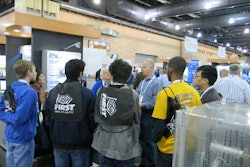Increased automation has changed the manufacturing industry in the U.S. Manufacturers are rapidly introducing robotics to the assembly line. In fact, North American companies bought 32% more robots in 2017 than in the same period in 2016, according to the McKinsey Global Institute, a British private-sector think tank.
And according to PMMI Business Intelligence’s 2017 Evolution of Automation Report, four out of five companies participating in the report's survey predict robot use will continue to increase due specifically to lower cost collaborative robots. More generally, it states that 90% of participating companies are already using robots somewhere on the line, and predict usage will continue to rise.
The ARC Advisory Group agrees in principle, and notes that despite the current rush toward robotic automation in the packaging industry, the space still is nowhere near saturated with automation and robotics.
“Robots are now used in 94 percent of packaging applications, including sorting, orienting, case packaging, multi-SKU packaging, and palletizing. This doesn’t mean that 94 percent of all packaging lines are now ‘robotized’; it merely indicates that machine builders are embracing the technology and finding new and better ways to deploy robots to handle specific tasks,” says David Humphrey, Director of Research at ARC Advisory Group Europe, and a key author of ARC’s Packaging Machinery and Automation Global Market Research 2017-2022 report, featured recently in this space.
So by all accounts, robotics are here to stay and will only continue to proliferate. And in many cases, the continued march toward automation is due to lack of skilled labor to complete such tasks. But there’s another side to that coin. The adoption of automated robotics is expected, at least by McKinsey, to eventually eat into the existing workforce.
Human workforce will need to adapt
In a December 2017 report, (the Executive Summary is available here), McKinsey ominously predicts that between 39 million and 73 million jobsin the U.S. could be lost to automation.
Jonathan Wilkins, marketing director for EU Automation, a global supplier of refurbished and obsolete industrial automation spares, explains.
“Manufacturers are introducing robots to the factory to meet customer demands because they can quickly and efficiently complete tasks to increase productivity andhelp companiesremain competitive.But as manufacturers rely more on technology, the human workforce will need to adapt tomake the most of the new technology available to them,” he says. “The actual number will depend on how rapidly the country adopts automation in each sector, how the growing aging population will change demands and how each sector will have to adapt to support economic growth.”
The job types in the balance
Wilkins says that robots can complete many blue-collar jobs currently completed by humans more quickly and more accurately. Technology optimizes production but needs humans to make a difference. There are jobs in a range of industries that require human qualities, such as intuition, creativity and care.
“Many manufacturers automate tasks that are repetitive, straining and time-consuming for humans. Instead, the human workforce can move to roles that require more soft skills such as collaboration, communication and problem-solving,” he says. “Some people may also choose to move across sectors. As education improves, people will have a wider range of skills that they can apply to roles in different sectors and choose to move around different job roles rather than staying in a similar role throughout their working life.”
What we need to do
According to Wilkins, the best way to reduce unemployment due to automation is to manage the transitionfrom human led to machine led facilities. And the best way for employers to do this is through retraining.
“The McKinsey report suggests that between 16 million and 54 million workers, or around a third of the US workforce, will need retraining for entirely new occupations. Employers should invest in retraining the staff they already have to complete more creative jobs in the facility,” he says. “Changes in the workforce will ultimately depend on how rapidly automation changes the manufacturing sector. However, we should not assume that the robots will overthrow us like they do in themovies. Manufacturers must invest in retrainingto ensuretheir workers are in a secure role.”





















